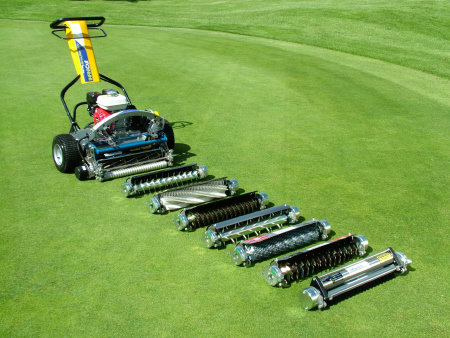
Couple the fact that climatic trends seem to blend our seasons into one, and that golf is increasingly being played year-round, and it is obvious that a club’s maintenance regime is under severe pressure. Indeed, the phrase ‘winter greens maintenance’ could nowadays be better described as ‘winter preventative maintenance’ – and effectively begins in January and ends in December!
Turf surfaces can only be manipulated effectively while decent growing conditions exist. Any activity that leads to plant stress requires rapid recovery, or sward thinning will result. Logically this means that remedial maintenance will be limited during the ‘winter’, when growth is less active.
Greens need to be managed in the summer to minimise damage during slow growing periods and managed in the winter to give the greens the best possible chance of emerging from winter with full grass cover.
A critical aspect of ensuring a successful winter is the retention of grass cover, regardless of variety. Weak greens that enter the winter season will undoubtedly lose grass cover quicker than those that have a dense, strong sward. So good maintenance practices should be employed during the lead up to the autumn season.
Simple decisions can be made such as increasing the height of cut, rolling more often in place of cutting and shallow tining to aid gas diffusion. More complex routines in the form of nutrient balancing, use of PGRs and pesticide applications also play a vital role in making sure a high percentage of grass cover is maintained when growth is good.
During those months when growth is slow, the greens still require cutting, albeit on a less regular basis. As the grass is less able to combat wear, it is therefore beneficial to look at ways of reducing stress while maintaining mowing style practices. The simplest way to do this is to increase the height of cut and to move over from triplex mowing to pedestrian mowing. Any remedial maintenance, even rolling with a triplex, can result in lateral movement of the softer turf through the torque action of the tyres and so induce plant stress and nullify the benefits of the practice employed.
Mowing with a floating head ATT INFiNiCutTM pedestrian mower is overall much more discretionary as the operator can select areas of turf that are weaker and ‘lift back’ on the unit. The ‘clean-up cut’ is also far less stressful on the plant. Indeed, even during the normal growing season, there is a strong case when mowing the ‘clean-up cut’ to slightly lift the HOC to reduce stress. It is no coincidence that the origin of diseases, often affecting greens, begins on the clean-up cut where stress on the plant is much higher. The cost of using a pedestrian mower may be slightly more expensive, but it can be a major cost saving initiative against the cost of chemicals.
In the winter rolling, particularly vibratory rolling with the ATT SMARTVibeTM cassette swapped in to the INFiNiCutTM, limits the stress on the slow growing grass plant. It is a clever method of making surfaces acceptable for play and an excellent solution compared to a hefty roller where soil particles may slide across one another creating compaction. It would be of no benefit rolling greens, to save on the stress of cutting, if the action of a triplex nullified the advantage. Shallow tining, without the use of a triplex, is also helpful with gas diffusion and limits anaerobic conditions
The ATT INFiNiCutTM doubles as a complete maintenance system, and is a constituent part of the INFiNiSystemTM total turf refinement system of nine SMART cassettes to cover all maintenance activities.
image INFiNiCUT and all its different cassettesEly City GC 033.j

